Although its size is not comparable to that of other large cities (40,000 inhabitants, approx.), there is much to see in Chefchaouen. This town located in the Rif Mountains is also known as Chefchaouen and is one of the best tourist destinations in northern Morocco. Its historic area still has the charm of the small town it once was, which captivates all its visitors. It is hard to forget for its visitors, especially because of the color that invades its whitewashed houses: blue in different shades, mainly light blue, which gives it a truly picturesque air.
But tourists in the premium segment may have a question: can you organize real luxury trips to Chefchaouen? The answer is yes: the top-tier proposals continue to advance and it is possible to enjoy this destination with the highest standards of comfort. On this page we tell you what to do in Chefchaouen and if there are luxury accommodations, in addition to giving you other useful information: when to travel to Chefchaouen according to its climate, how to travel to it, what are its best monuments, etc.
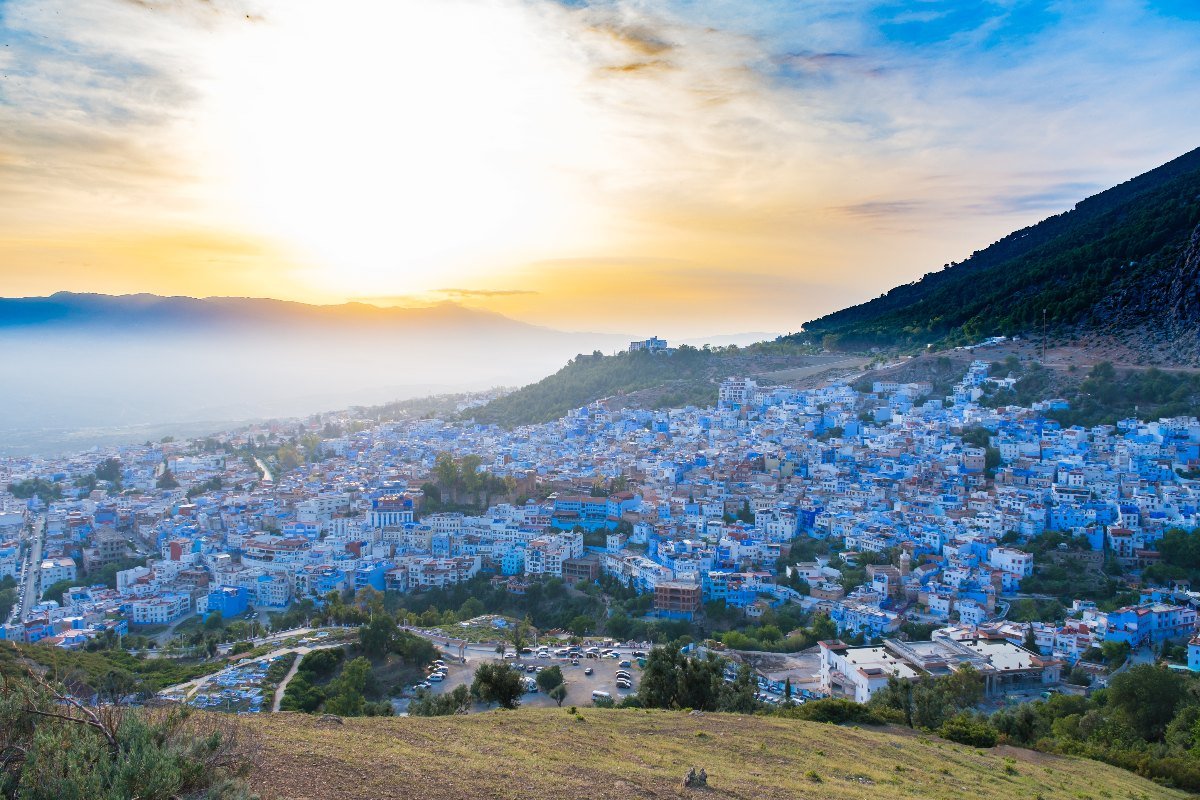
Chefchaouen is located in northern Morocco, in the heart of the Rif, the mountain range that runs more or less parallel to the Moroccan Mediterranean coast. Therefore, although it is relatively close to the sea (about 45 km as the crow flies), it is also at a considerable altitude: about 600 meters above sea level. It is part of the Tangier-Tetouan-Al Hoceima region, and is the capital of its own province.
This is a list of distances that separate it from the most important cities, in case you are considering taking a luxury trip to Chefchaouen together with other important destinations within the same circuit:
The location of Chefchaouen is very peculiar, and is at the origin of its name: it is located at the foot of two mountains (the Tisouka, of 2050 meters above sea level, and the Megou, of 1616 meters above sea level), which from the surroundings have the appearance of horns. This is probably why the name Chefchaouen was used to refer to this city, because in Berber it means something like “look at the horns”.
This peculiar location influences the local climate and, therefore, the decision of when to travel to Chefchaouen. Let’s first look at the main climatic characteristics and then justify the decision.
As we said, the altitude of Chefchaouen is considerable: about 600 meters above sea level. That, together with its mountainous environment in the Rif, gives it cooler temperatures than those of other Moroccan tourist destinations. In spring and autumn, the minimums can be around 10ºC, with mild and pleasant maximums of about 20ºC. In summer, it is hot but the temperatures are not suffocating: 30ºC average maximum and 20ºC average minimum.
However, winter is noticeably cold: without suffering freezing temperatures, the winter minimums can approach 0ºC or even fall below that threshold, while the maximums remain at 10ºC-15ºC.
The precipitation season is concentrated from October to April, at which time 30% of the days are considered rainy. Snow is a rare phenomenon, although it can sometimes occur. What is not so infrequent is fog, except in the warmest season: this fog can cover the peaks of the mountains that surround Chefchaouen, but sometimes descends to the level of the population, limiting visibility from the panoramic viewpoints but giving a mysterious ghostly appearance to the hamlet.
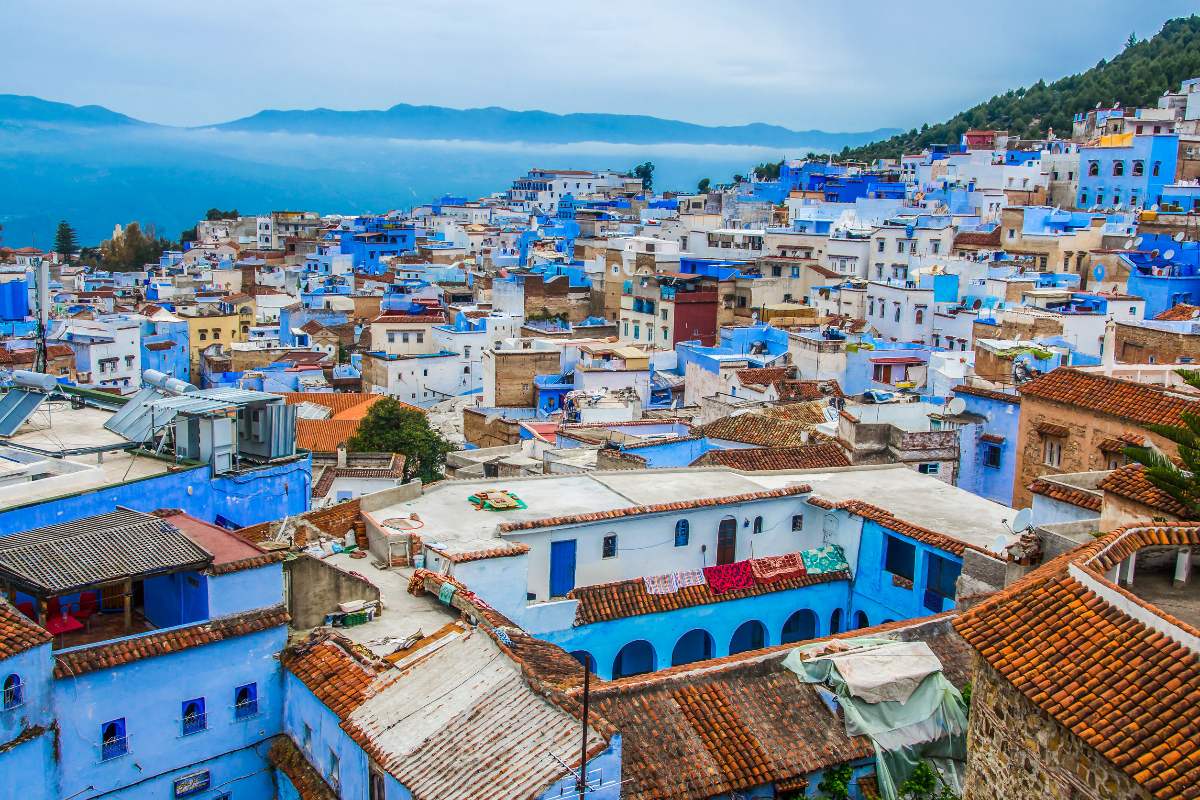
Taking all of the above into account, it is worth asking when to travel to Chefchaouen. And the truth is that any time of the year is valid and has its advantages. For many, the ideal period is the spring: the Rif environment is tinged with green or even other colors thanks to the flowering of its plants, and the temperatures are very pleasant. In addition, the countless pots that populate the windows and patios of the medina are also filled with colorful flowers, and that is undoubtedly one of the best images to see in Chaouen. At that time, there is still the “risk” of finding a rainy day, but they are not usually excessively heavy rains.
Autumn is also a
In the summer, the heat can be noticeable, but not prohibitive: that makes Chefchaouen a fairly popular Moroccan destination, because being a holiday season, it is very attractive to spend a few days here or visit it from other coastal destinations of the Mediterranean, especially Tetouan. Of course: at this time it is advisable to redouble the protection against the sun: although the temperatures are not as high as in other regions of the country, the altitude of the city and its surroundings means that solar radiation is also higher. Therefore, cream, sunglasses and caps or hats will become more necessary than ever.
At the opposite extreme, winter is the time when tourism slows down, but that can be a good incentive for many. Rain and fog may be present, and the cold can be intense in the morning and at night, so a coat and perhaps an umbrella will become necessary allies.
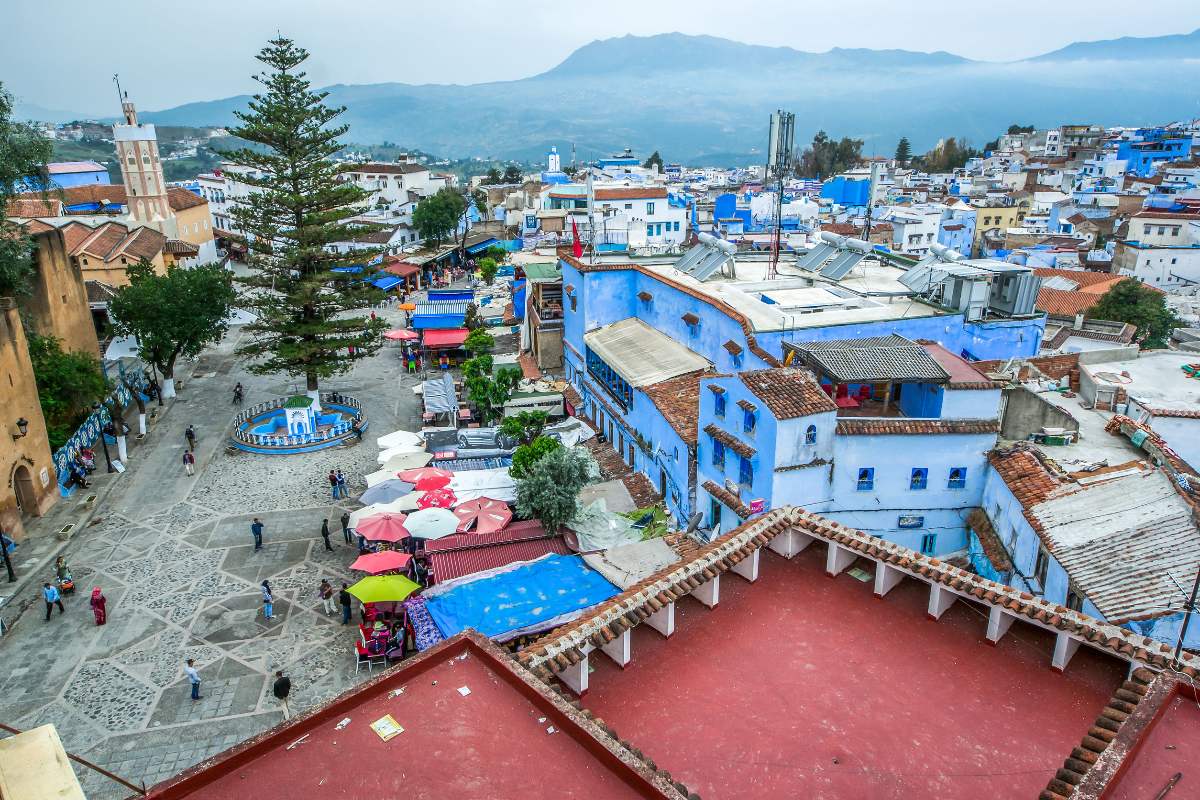
The peculiar orography and location of Chefchaouen provides magnificent panoramic views and images to see in Chefchaouen, and has contributed to preserving its medina almost intact, but it also has a disadvantage: the transport connections are limited, compared to other destinations in the country.
For example, it lacks its own airport: the closest one is almost 70 km away and is Tetuán Sania-Ramel. However, which is not too great a distance, so it can serve as a direct gateway from international destinations with air routes to here, such as Spanish (Alicante, Barcelona, Madrid, Malaga), French (Paris, Marseille), Brussels or Amsterdam, although some of these flights are only seasonal.
The other reference airport for Chefchaouen is Tangier-Ibn Batuta, about 120 km away. The journey from here is longer, logically, exceeding two hours by road, but in return the list of connected international airports is greater, mainly European airports (Spain, Italy, France, Netherlands, Belgium, United Kingdom, Portugal, Denmark and even Turkey), thus facilitating the luxury trips to Chefchaouen, with the support of a premium vehicle with driver for this transfer.
On the other hand, the railway is also not established in the city, due to the complex orography of the place: neither high speed, nor night trains nor conventional trains. However, due to the increase in tourism in Chefchaouen, it has been planned to create a conventional railway line that connects it with Tangier, with an intermediate stop in Tetouan. In any case, on the date of writing this content (June 2025), it was only a future project.
On the other hand, it does have a bus station that connects the city with others in northern Morocco and even with other important and more distant destinations, such as Rabat or Casablanca. In any case, although the companies have been improving and updating their fleet of vehicles, it cannot be considered a valid option for luxury trips to Chefchaouen.
So, as all the ways to get to the city involve the road option, premium travel packages need a premium vehicle with driver, such as those of Chic Morocco, to proceed with transfers to/from the airport, for travel to/from other cities or for excursions around the environment, such as those described below in the section “”What to do in Chefchaouen.
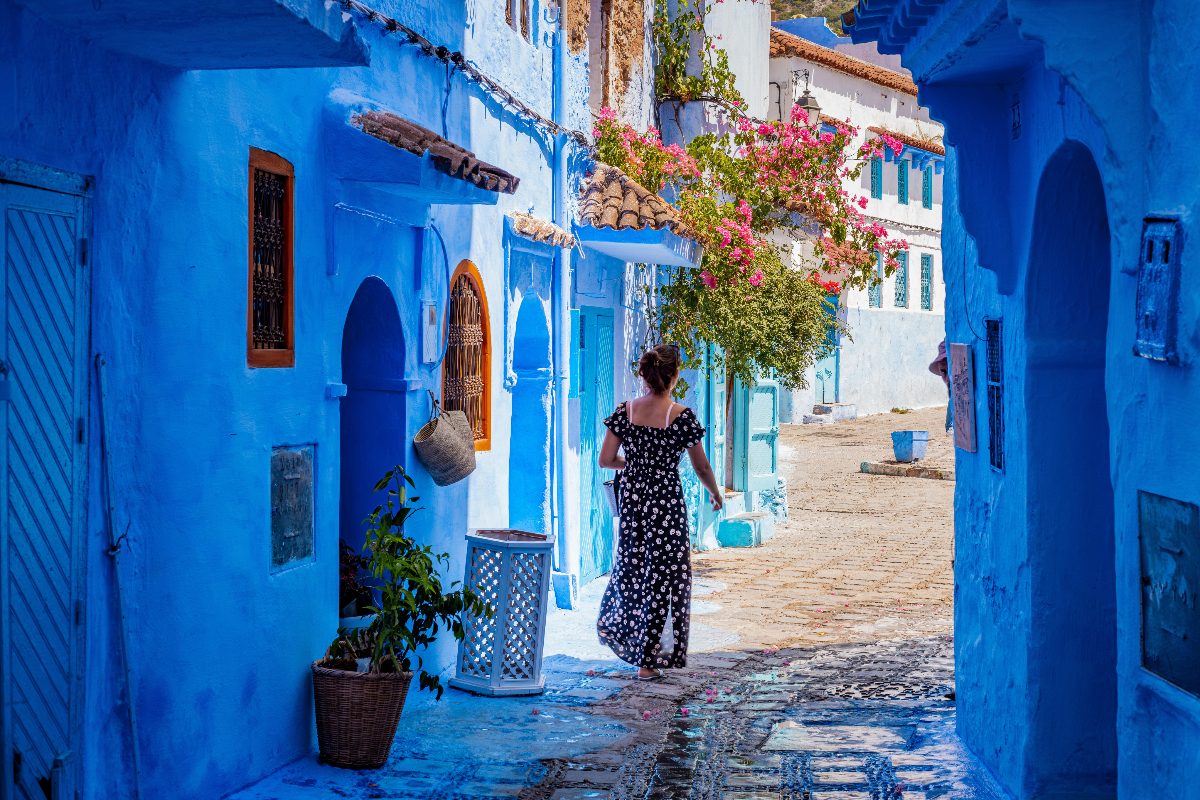
Unlike other tourist destinations in Morocco, which have their roots in Prehistory or Antiquity, the history of Chefchaouen has “only” six centuries. However, this period is very interesting and important to understand this unique place in the north of the country.
Popular tradition attributes the founding of Chefchaouen to a great gesture of love: the legend speaks of Sultan Moulay Ali Ben Rachid, in love with Zhora, a girl from Vejer de la Frontera (Cádiz, Spain) who had been expelled along with more Muslims from the south of that in the 15th century. To give her happiness, he promised to build a town that would remind her of hers, for which he ordered the construction of Chefchaouen.
The reality, however, seems harsher and more pragmatic: Chefchaouen was founded in 1471 as a place from which to harass Ceuta and Alcazarquivir, then dominated by the Portuguese. It is true that the population of this small village grew enormously after the expulsion of the Jews from Spain at the end of the 15th century and of the Moors at the beginning of the 17th century, which explains its resemblance to so many villages in southern Spain: perched on the slopes of a hill, narrow streets full of nooks and crannies and impossible slopes, whitewashed houses…
The existence of springs in its territory (Ras al-Ma) soon turned it into a sacred city for its inhabitants and for other Muslims in the country, being the final destination of multiple pilgrimages that continue to occur today. This also meant that the residents of Chaouen for a long time zealously guarded their village against foreign visitors, which favored its genuine preservation, almost without substantial modifications in the early days of tourism.
However, following the establishment of the Spanish Protectorate with its capital in Tetouan, the Spanish troops “opened” Chefchaouen to the outside, making it known, although not without overcoming a bitter opposition. It is no coincidence, therefore, that Chaouen played a prominent role in the Rif War, which led to the proclamation of a short-lived Rif Republic in this area. And from this time date some of the things to see in Chefchaouen, as we show below.
In any case, after the independence of Morocco in 1956, Chefchaouen was gradually opening up to foreign tourism, like most of the country’s monumental destinations, knowing that this industry can bring great benefits to the economy, heritage and local traditions.
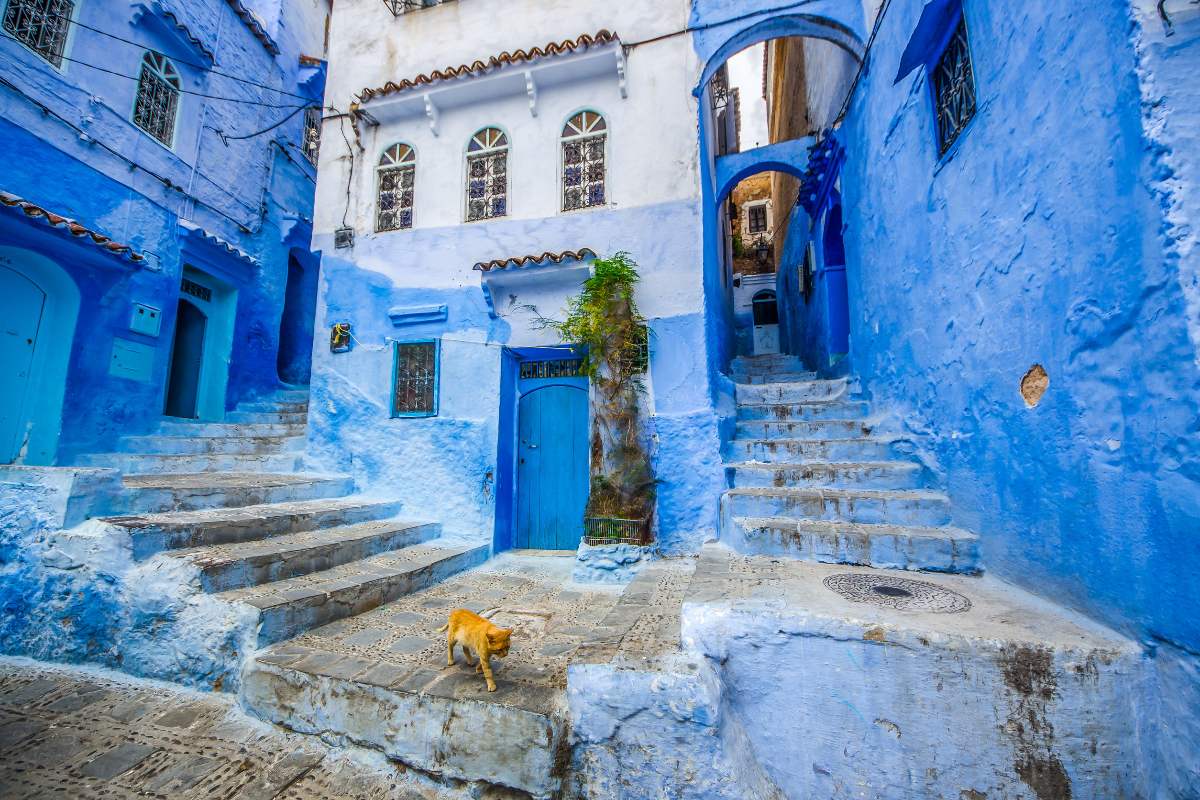
A luxury
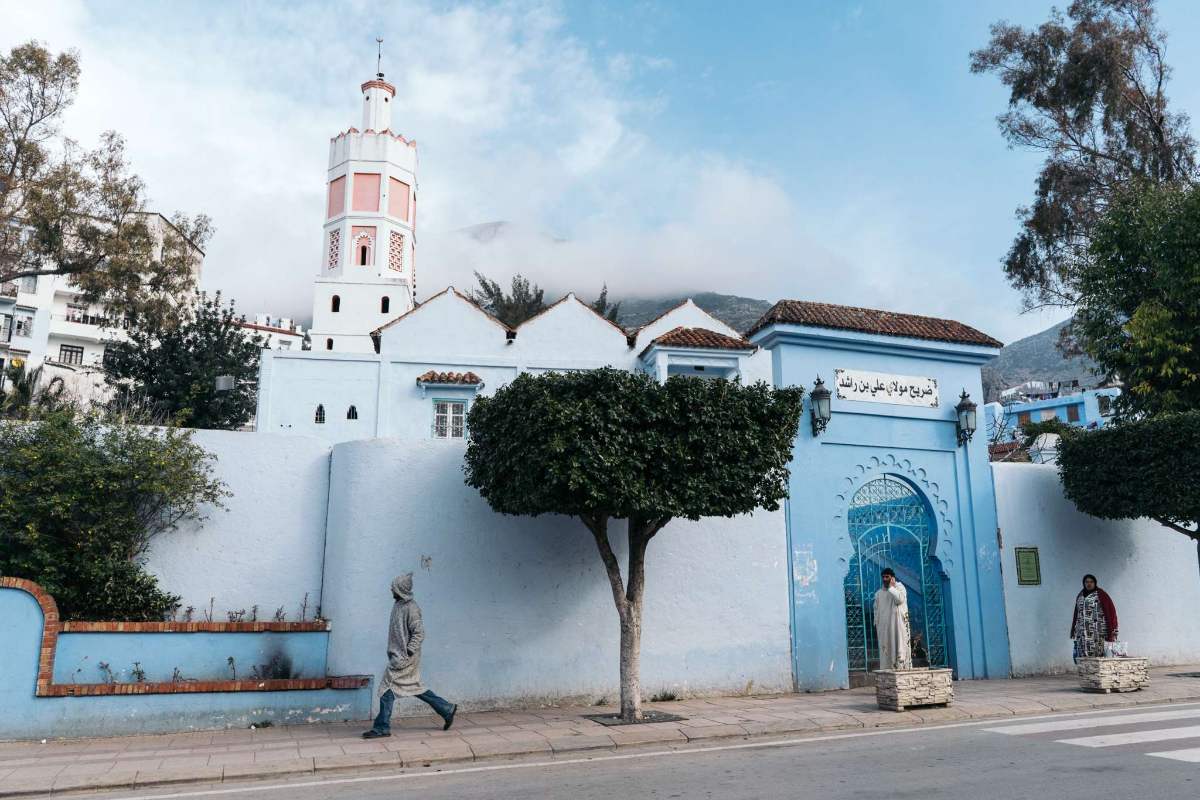
The places of interest that you have to see in Chefchaouen can be ordered according to two large areas: inside the medina, where a good part of them are concentrated, and outside the medina. In addition, we dedicate another section to the excursions to do in Chefchaouen and its surroundings, as a good part of its attractions are in the mountains and surrounding natural areas.
The medina, which extends along the hillside where it sits, houses a good part of the places of interest that you have to see in Chefchaouen. Its location, in addition, promotes one of the most charming elements: its irregular layout, with steep streets, impossible nooks, stairs to overcome the unevenness and corners of this type. In addition, in many cases viewpoints arise almost by surprise, with views towards the surroundings or towards the medina itself, because between the lowest part of the medina and the highest there is a difference in level of about 100 meters.
In addition to the following places to see in Chefchaouen, what really gives beauty to the historic medina is the color that permeates everything: the blue, combined with the white of the whitewashed walls, the golden and reddish tone of the adobe and the natural brown of the stone in certain important constructions. Nor can we forget the tiles that cover many walls, curbs, steps and other spaces, in tones that are in tune with the environment: white, blue and much more. To all this is added that the inhabitants of the medina are authentic artists of color when arranging flowers in pots, either hanging from the walls, supported on the ground, in the windows and in many other unimaginable places. And as if all this were not enough color and charm, the craft shops themselves that show their wares at their doors end up providing an almost magical, truly inspiring atmosphere, demonstrating that popular art is the most genuine and authentic.
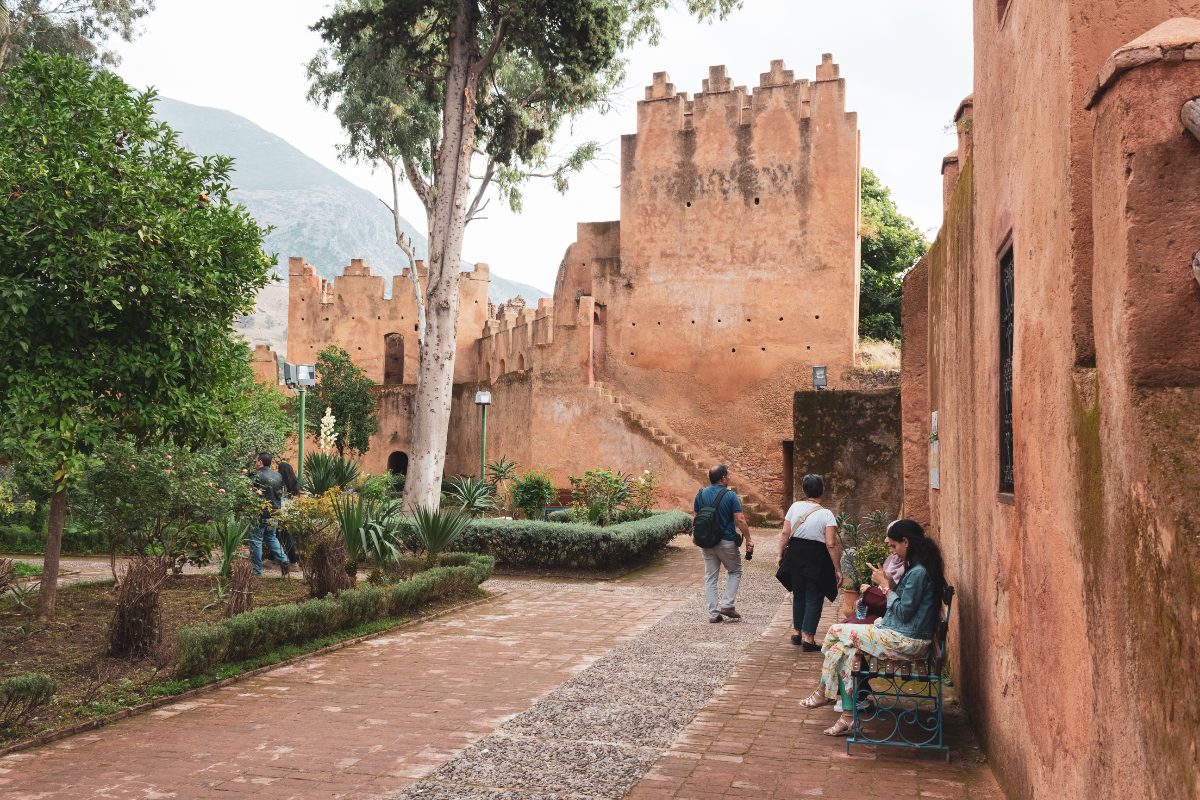
If we focus on the historical and monumental constructions to see in Chefchaouen, the list gives us spaces worthy of knowing and photographing. For the inhabitants themselves, the reference building is the Kasbah: it is a construction of defensive origin, at the gates of the medina, on its south side, in the heart of Uta el-Hammam Square. It was built in the 15th century, at the same time as the founding of the city, which had a mainly military origin (harassment of the Portuguese squares of northern Morocco). Its impregnable architecture is evident and, in addition to functioning as a castle, it served as a prison since its origin, with cells intended for the imprisonment of captured enemies. Its crenellated perimeter and its watchtowers are preserved in very good condition. No less interesting is its Andalusian garden, which at the time was a parade ground but is now a perfect place for rest and disconnection.
The kasbah, by the way, now has a very different use: it has become a museum, the most important in the city, in this case dedicated to local ethnography (not only of Chaouen but of the entire Rif). An important part of the collection is made up of weapons, such as daggers, but also later ones that worked with gunpowder, such as rifles. There is no shortage of carpentry and cabinetmaking work, in pieces such as chests and coffered ceilings. And of course, there is no shortage of ceramics, with its own distinct personality, unlike that of other cities such as Fez: in this case, red and black predominate in geometric compositions.
Another construction that you have to see in Chaouen is the Great Mosque: although it is not as monumental and refined as other mosques in the country, its minaret has a lot of personality. It is believed that it may have been inspired by the Torre del Oro in Seville (Almohad construction from the 13th century) due to its similar octagonal plan, in this case with a predominance of golden (adobe) and brownish-red (brick trim) colors. It is practically contemporary to the kasbah, with origins in the 15th century.
As with the rest of the mosques in Morocco, access is only allowed to Muslims. That is also the case of the White Mosque, named for the predominant color of the complex. Despite its recent construction (early 20th century), it stands out for the elegance of the minaret, decorated with sections of white sebka.
The Plaza el Hauta is one of the most charming corners to see in Chaouen old: of small dimensions, it is an irregular square named for the monumental fountain located in it, which still offers water to its citizens (many of them get their supply there). It is a small temple with a hipped roof. The square is made up of different buildings with a gallery and a first floor of arcades, where there are different establishments to have a drink, especially its always appealing orange juices.
Plaza el Hauta is not the only one located inside the medina: in the eastern sector is the Plaza de Makhzen, due to the proximity of Hassan II Avenue, one of the busiest and most lively in the center.
But if we talk about squares, special mention should be made of the Plaza de Uta el-Hammam, where the medina and the new city come together. In addition, it acts as a starting point for many tourist routes things to do in Chaouen. The aforementioned kasbah and Great Mosque overlook it, and its entire perimeter is full of bars, cafes and restaurants. But rivaling them is a most imposing element: its spectacular Atlas cedar, a species considered “national” due to its abundance and uniqueness. And this is a good example of the many specimens that are in the Rif, reaching a height and slenderness worthy of photographing.
We cannot forget about the access doors to the medina which, as was customary, was walled. In this case, the doors are distributed in very different places, in all cases, made up of a beautiful arch. You can mention Bab el-Ansar, in the northern part of the medina and built in the 16th century. Bab el-Mellah also has a lot of charm, very close to the kasbah, and was the door that led to the Jewish quarter of the city. For its part, Bab el-Mahrouk is located in the highest sector of the medina, which is synonymous with panoramic views in its surroundings. And Bab el-Souk gives access to one of the areas with the highest concentration of shops (souk).
In any case, what you have to do Chaouen is get lost in its corners, climb slopes that lead to humble but centuries-old houses, go down stairs that lead to anonymous squares, turn corners that present you with viewpoints of the Rif, admire flowered balconies and doors with large horseshoe arches, shop windows that fill the street with color with their handmade products…
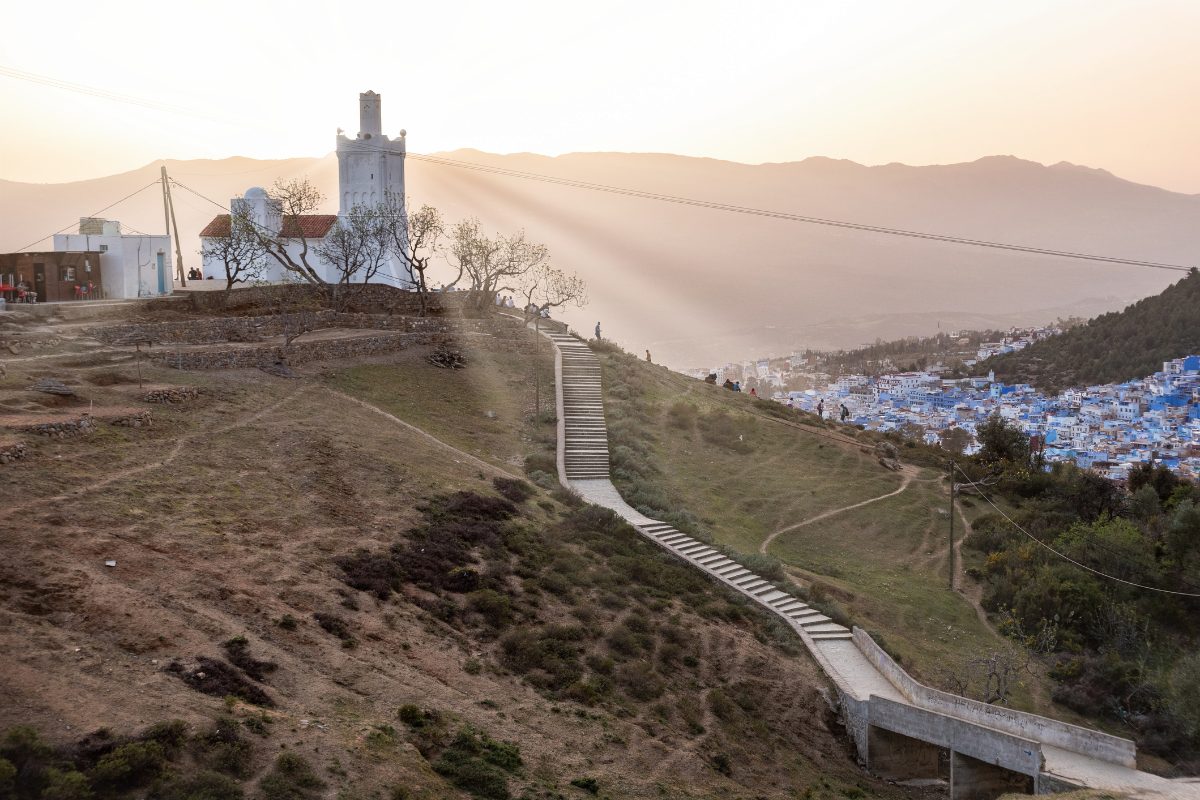
All the places mentioned before are inside the medina or bordering it. But there are many other places to see in Chaouen and that are outside of it: in some cases, very close to the old town and in other cases, in the new “Chaouen”. In the first case, it is worth traveling to the Fouara stream, a small stream that in winter and spring brings more water, at which time the laundresses come with their baskets of clothes to wash and spend some time in company. The Ras el-Maa Fountain is perhaps the most spectacular place in this sector, especially due to its waterfall, quite a sight when the water flows down with force.
The Sebbanin bridge is also a charming construction over this stream, and the entire surrounding neighborhood is known as the laundry neighborhood. In its surroundings there is one of the oldest mosques, from the 15th century.
In addition to all these places of interest located in the charming historic medina, you can take a stroll through the new part of the city. Mainly, along two avenues that will remind the traveler of the period of the Spanish Protectorate of the early 20th century. Hassan II Avenue runs along the entire southern flank of the ancient wall of the mosque, while the Plaza de Mohammed V will provide a moment of rest: in the center of it there is a small park with vegetation, arcades and benches decorated with tiles, which represents another meeting point for the population.
Another of the favorite places for locals and foreigners is the Spanish mosque: it is one of the places you have to see in Chaouen for its history, for its architecture and for its surroundings. It is named so because the authorities of the Spanish Protectorate ordered it to be built to ingratiate themselves with the local population, at a time of high tension due to the so-called Rif War. It was never used as such, perhaps because the Muslims themselves never considered it their own, but its neo-Andalusian style is clearly indebted to southern Spain. To get here you have to walk a good stretch uphill from the medina, crossing the Fouara stream, or take a car to its door. In both cases, contemplating the city and its green surroundings from the foot of the temple will be one of the highlights of the trip.
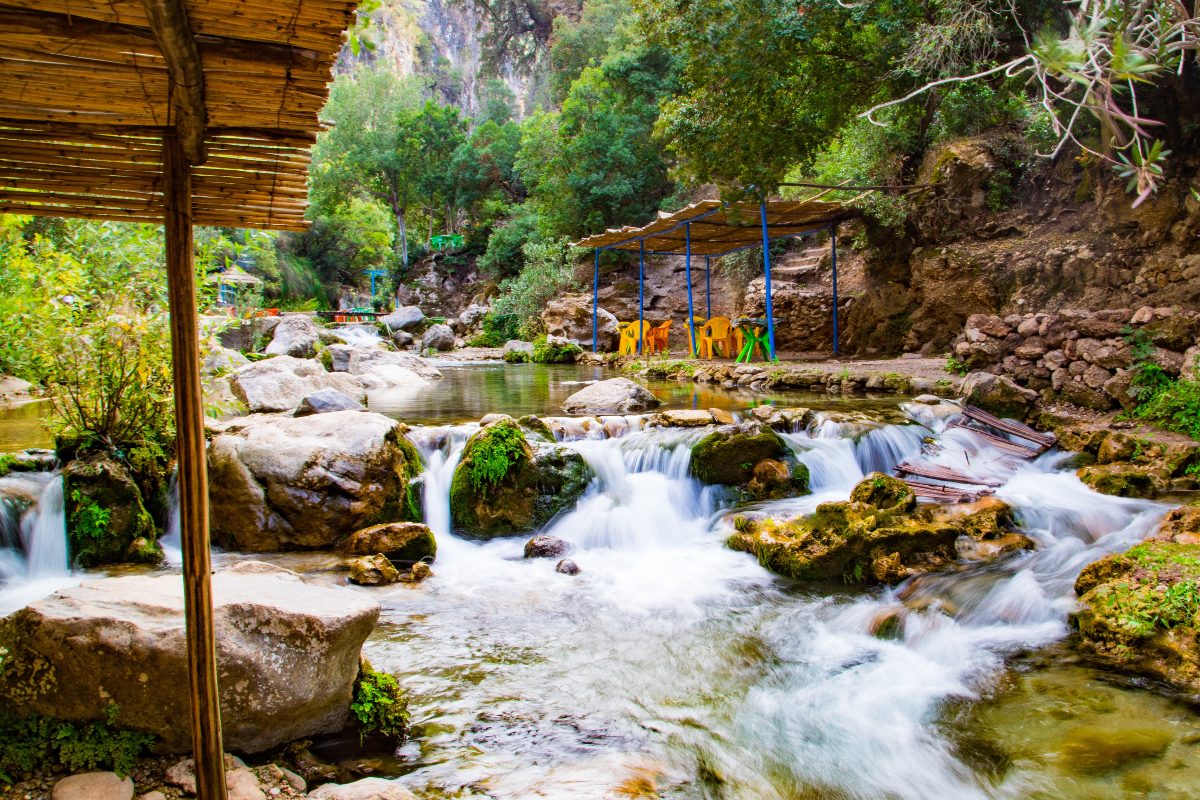
If you have the possibility of traveling outside the city (as will be the case, if you have our vehicle with driver service), you can find places of enormous beauty in the surroundings, especially natural. In fact, Chaouen is considered one of the paradises of hiking travelers, as there are numerous walking routes through the Rif mountains.
Many of the routes to do in Chaouen and its surroundings are concentrated in the Talassemtane National Park, about 30 km from the city. The large size of the park and the variety of routes has led to the emergence of specialized guides and companies, capable of organizing a multi-day route through the most representative places of this protected space.
One of the most popular routes among travelers is that of the Akchour waterfalls: these are waterfalls that add up to several tens of meters of fall. The water, when falling, is dammed in small pools, which encourages many people to take a refreshing swim in warm weather, despite the cold temperature of the water.
Another corner full of spectacularity is the famous Bridge of God. This powerful name is due to the imposing shape of this natural arch, created by the erosion of the rock and whose contemplation is an inspiration. Its balance is a challenge to nature, and it is spectacular when viewed from below.
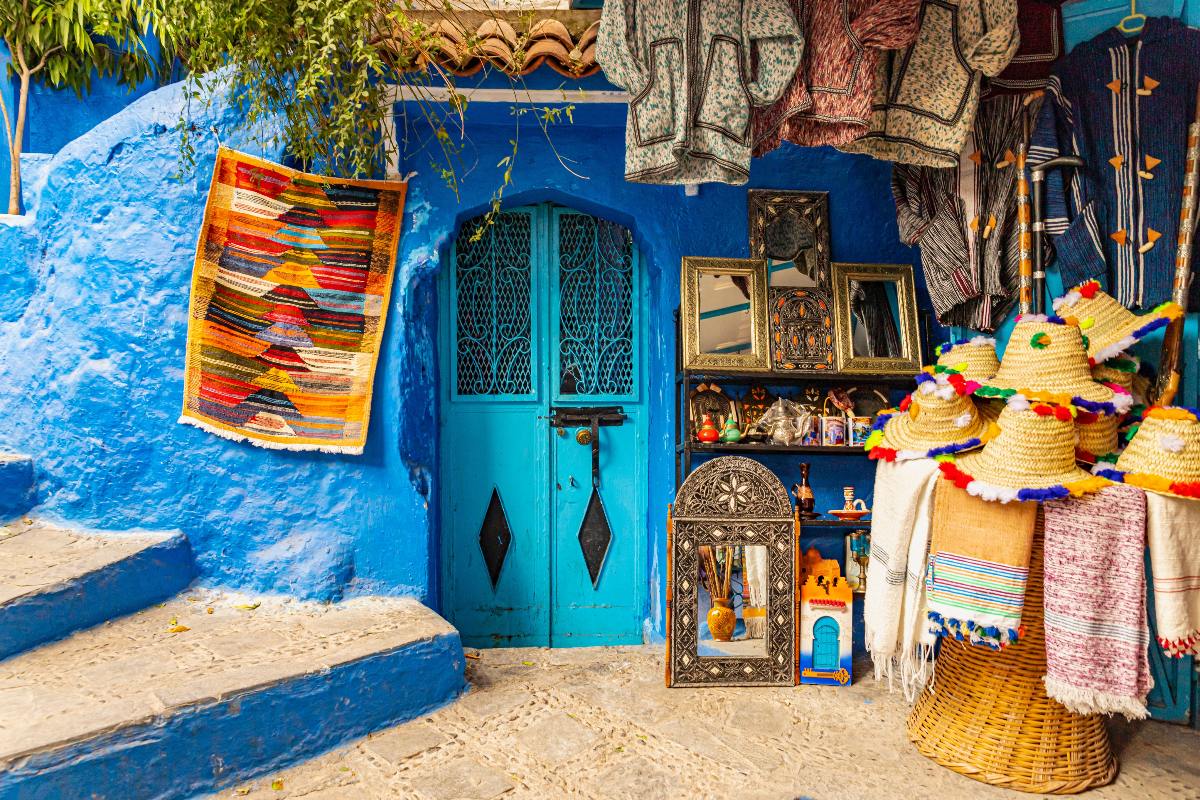
Strolling through the medina and taking a natural getaway through the Rif environment are two of the best things to do in Chaouen. But they are not the only options: in the following lines we tell you other proposals and, as you will see, they all have in common their character “slow”, as this small charming city is a magnificent place to savor slowly and without haste.
One of those proposals to do in Chaouen is to visit the viewpoints. From them, you can enjoy the sunrise, the sunset or simply the beauty of the city’s skyline, with its white and blue houses and the Tisouka and Megou mountains on both sides. For many travelers, these viewpoints are perfect places to read outdoors, or even draw or paint, as the panoramic view that surrounds the view serves as authentic inspiration. In addition to the viewpoint of the Spanish mosque or that of Bab el Mahrouk, the list of strategic points to contemplate the surroundings is very extensive: that of Corniche or that of the surroundings of the Archer Cave, several kilometers up the road.
Another pleasure that few can resist is a relaxing bath. And in the luxury trips to Chaouen, the experience is not focused on the hammams public but in private spa centers, which are part of wellness centers. In them, the same concept that has given fame to the Arab baths is followed (several pools with temperatures at different temperatures, with an orderly route to eliminate toxins and release stress), but premium services such as massages are also added.
Buying local crafts is also another plan to do in Chaouen. And not only because the medina is full of shops where all kinds of handmade products are sold, but also because those articles are really genuine and made by artisans from the Rif. In this way, you can get in touch with local techniques and materials. For example, thick garments made of sheep’s wool, a sign that winters are harsh here. Or natural leather to make bags, backpacks, belts, slippers and much more. Articles made in ceramics are never lacking, as are wicker basketry works and other natural fibers.
Although this city exudes humility in every corner and is visited by many international “backpackers”, luxury trips in Chaouen are also a reality. In fact, in recent years professionals and companies have emerged that maintain quality standards at the highest level.
This can be seen in the spa centers to enjoy a hammam circuit. While there are still public baths for the local population, with separate hours for men and women, in the case of private hammams the experience is aimed at all types of travelers, without the need to follow the strict separation mentioned. Some of these hammams are located in high-category hotels, as it is a “plus” service that makes the difference. But in other cases they are spa centers created for this purpose.
The same happens with gastronomy: although many locals are popular, humble and casual in the squares and alleys of the city, there are others that attract less attention and offer a level of excellence. At Chic Morocco we will know how to advise you or book the best gastronomic experiences in the city.
As we said, on a luxury trip to Chaouen , private transport: to be able to arrive and leave the city, and also for trips around the surroundings. And since driving on local roads is not always easy for a foreigner who is not used to it, the best solution (and the safest) is to have a premium vehicle and a local professional at the wheel. That is what Chic Morocco provides in all packages, with total availability.

Within this section on luxury trips to Chaouen, accommodation deserves special attention, as this largely determines the level of satisfaction with the trip. And it can be said that there are many charming accommodations in Chaouen, responding to different typologies.
For example, there are many riads in the medina: old houses that served as housing for the local population but have become the most welcoming boutique hotels. However, not all riads can be considered high-level, so it is worth choosing wisely. The patio decorated with vegetation, tiles and water fountains is the key to providing this feeling of relaxation and well-being, and the atmosphere and comfort of the rooms must also be up to par.
However, for obvious space reasons, some riads may lack a pool, gym and other premium facilities. And that is precisely the strong point of the hotels of the “classic” type, in more spacious buildings and on larger plots to be able to integrate these services. Although the arrival of large chains is slower here than in other Moroccan destinations, there are hotels capable of satisfying the most demanding. Among the many examples that can be mentioned are the Lina Riad & Spa or the Riad Cherifa. And also many others that, for sure, will emerge in the coming years.
Another type of charming accommodation in Chaouen is the gite. Or rather, in the natural environment of Chaouen, as they are the equivalent of rural houses or ecotourism accommodations. In this case, they are located in the Talassemtane National Park and are large buildings located in the heart of nature, also serving as a “base camp” for excursions around the area.
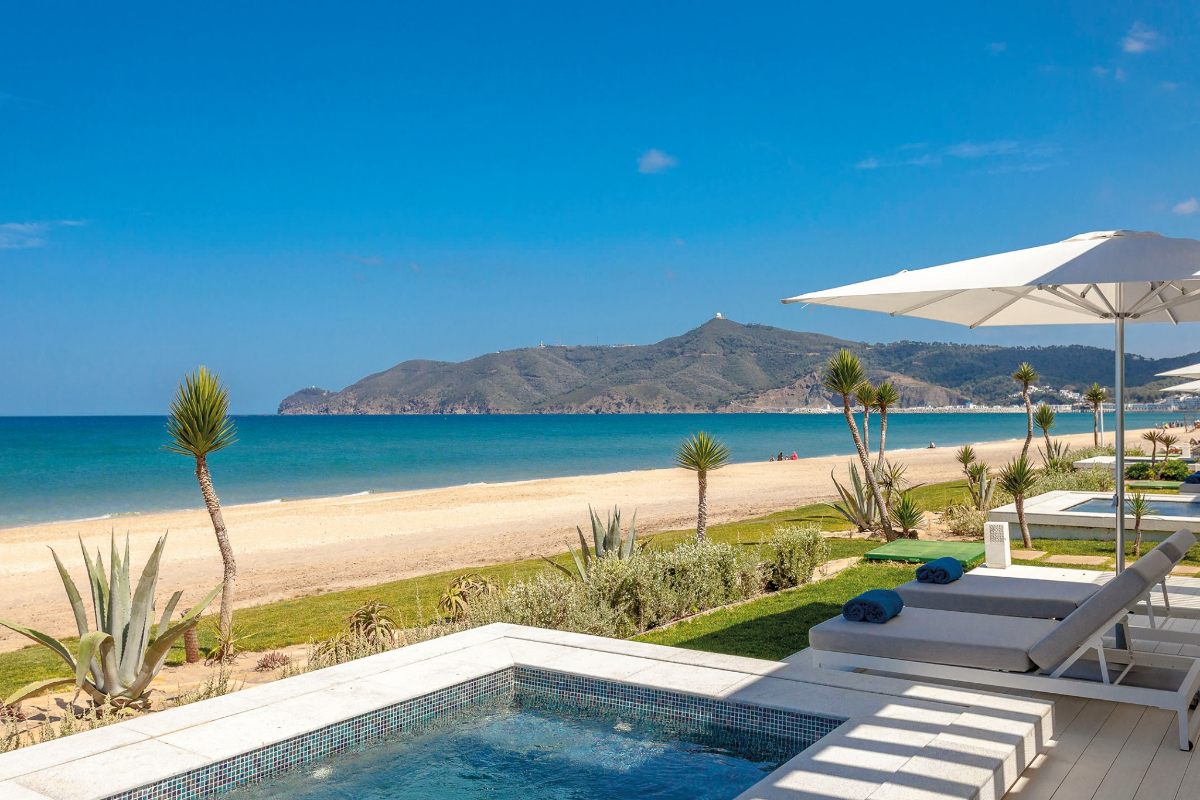
So far we have reviewed the experiences and services that can be included in luxury trips to Chaouen. However, an alternative to consider can also be mentioned: Tetouan. That is: the proximity of this city, just 60 km to the north, allows it to be considered as a city from which to visit Chaouen as an excursion. And the advantage of this option is that the level and variety of tourist services is even more sophisticated here.
Especially in the coastal area: Tamuda Bay. Known by many as the Costa del Sol of Morocco, this is where major resorts with large facilities and maximum exclusivity are concentrated, where major signature restaurant chains, facilities for long vacation stays and other services always demanded by the most premium travelers have landed.
For example, golf: although this sport cannot be practiced in Chaouen and its immediate surroundings due to the lack of courses, in Tamuda Bay you will find several venues, most of them built in recent years and, therefore, with modern facilities, greens in perfect condition and other associated services.
Therefore, if you want to organize a luxury trip to Chaouen or if you prefer to set your sights on Tetouan (Tamuda Bay) and from there take excursions to the “blue town” of the Rif, you can contact us. Our agency is an expert in trips throughout the country, including Chaouen and Tetouan, so we have the best suppliers for you to enjoy a simply unique experience. And in addition, our way of working will give you a unique experience: we will design your program to measure, with agents and advisors who will know how to integrate your preferences and requests into the service package.







